Nuclear Magnetic Resonance T1–T2 Spectra in Heavy Oil Reservoirs
Abstract
1. Introduction
2. Basic Theory of T1–T2 Spectra
3. Numerical Simulation and Inversion Algorithm Selection
4. Parameter Analysis of T1–T2 Spectra in Heavy Oil Reservoirs
4.1. Acquisition Parameters
4.1.1. Wait Time Group
4.1.2. Echo Spacing TE
4.2. Inversion Parameters
4.2.1. Convergence Tolerance tol
4.2.2. Maximum Number of Iterations itermax
4.2.3. Regularization Parameter
5. Conclusions and Prospects
Author Contributions
Funding
Acknowledgments
Conflicts of Interest
Appendix A
Appendix B
Appendix C
References
- Galford, J.E.; Marschall, D.M. Combining NMR and Conventional Logs to Determine Fluid Volumes and Oil Viscosity in Heavy-oil Reservoirs. In Proceedings of the SPE Annual Technical Conference and Exhibition, Dallas, TX, USA, 1–4 October 2000. [Google Scholar]
- Smith, C.K.; Wang, F.H.L. Sampling and Characterization of Rocks and Fluids for Heavy-oil Reservoir Management. In Proceedings of the SPE Annual Technical Conference and Exhibition, Denver, CO, USA, 21–24 September 2008. [Google Scholar]
- Liu, H.; Xiao, L.; Guo, B.; Zhang, Z.; Zong, F.; Deng, F.; Yu, H.; Anferov, V.; Anferova, V. Heavy Oil Component Characterization with Multi-dimensional Unilateral NMR. Petrol. Sci. 2013, 10, 402–407. [Google Scholar] [CrossRef]
- Xin, X.; Yu, G.; Chen, Z.; Wu, K.; Dong, X.; Zhu, Z. Effect of Non-Newtonian Flow on Polymer Flooding in Heavy Oil Reservoirs. Energies 2018, 10, 1225. [Google Scholar] [CrossRef] [PubMed]
- Coates, G.R.; Xiao, L.; Prammer, M.G. NMR Logging: Principles and Applications; Gulf Professional Publishing: Houston, TX, USA, 1999. [Google Scholar]
- LaTorraca, G.A.; Dunn, K.J.; Webber, P.R.; Carison, R.M.; Stonard, S.W. Heavy Oil Viscosity Determination Using NMR Logs. In Proceedings of the SPWLA 40th Annual Logging Symposium, Oslo, Norway, 30 May–3 June 1999. [Google Scholar]
- Bryan, J.; Kantzas, A.; Bellehumeur, C. Oil-viscosity Predictions from Low-field NMR Measurements. SPE Reserv. Eval. Eng. 2005, 8, 44–52. [Google Scholar] [CrossRef]
- Guo, J.; Xie, R. Numerical Simulation and Parameter Analysis of NMR T2–D Distributions of Tight Sandstone Saturated with a Gas–water Two-phase Fluid. J. Nat. Gas Sci. Eng. 2017, 37, 502–511. [Google Scholar] [CrossRef]
- Zhu, L.; Zhang, C.; Wei, Y.; Zhou, X.; Huang, Y.; Zhang, C. Inversion of the Permeability of a Tight Gas Reservoir with the Combination of a Deep Boltzmann Kernel Extreme Learning Machine and Nuclear Magnetic Resonance Logging Transverse Relaxation Time Spectrum Data. Interpretation 2017, 5, T341–T350. [Google Scholar] [CrossRef]
- Kleinberg, R.L.; Vinegar, H.J. NMR Properties of Reservoir Fluids. Log Anal. 1996, 37, 20–32. [Google Scholar]
- Freedman, R.; Johnston, M.; Morriss, C.E.; Straley, C.; Tutunjian, P.N.; Vinegar, H.J. Hydrocarbon Saturation and Viscosity Estimation from NMR Logging in the Belridge Diatomite. Log Anal. 1997, 38, 44–59. [Google Scholar]
- Mirotchnik, K.; Allsopp, K.; Kantzas, A. Low-field NMR Method for Bitumen Sands Characterization: A New Approach. SPE Reserv. Eval. Eng. 1999, 4, 88–96. [Google Scholar] [CrossRef]
- Wayne, C.; Doug, W. A Special Application of NMR Logging to Detect Heavy Oil on North Slope Satellite Fields, Alaska. In Proceedings of the SPE Western Regional Meeting, Anchorage, AK, USA, 26–27 May 1999. [Google Scholar]
- Sun, B.Q.; Olson, M.; Baranowski, J.; Chen, S.; Li, W. Direct Fluid Typing and Quantification of Onorico Belt Heavy Oil Reservoirs Using 2D NMR Logs. In Proceedings of the SPWLA 47th Annual Logging Symposium, Veracruz, Mexico, 4–7 June 2006. [Google Scholar]
- Chen, S.; Mette, M.; Jumagaziyev, D.; Shao, W.; Nina, A.B. Application of NMR Logging for Characterizing Movable and Immovable Fractions of Viscose Oils in Kazakhstan Heavy Oil Fields. In Proceedings of the SPWLA 47th Annual Logging Symposium, Veracruz, Mexico, 4–7 June 2006. [Google Scholar]
- Enninful, H.R.N.B.; Babak, P.; Kantzas, A.; Bryan, J. Fluid Quantification in Oil Sands Using a 2D NMR Spectroscopy. In Proceedings of the 13th Offshore Mediterranean Conference Exhibition, Ravenna, Italy, 29–31 March 2017. [Google Scholar]
- Prammer, M.G. NMR Pore Size Distributions and Permeability at the Well Site. In Proceedings of the SPE Annual Technical Confernce Exhibition, New Orleans, LO, USA, 25–28 September 1994. [Google Scholar]
- Zhou, X.; Nie, S.; Wang, Y.; Zhang, Y.; Yang, Y.; Yang, P. An Iterative Truncated Singular Value Decomposition (TSVD)-based Inversion Methods for 2D NMR. Chin. J. Magn. Reson. 2013, 30, 541–551. [Google Scholar]
- Ge, X.; Fan, Y.; Chen, H.; Deng, S.; Cao, Y.; Zahid, M.A. Probing the Influential Factors of NMR T1-T2 Spectra in the Characterization of the Kerogen by Numerical Simulation. J. Magn. Reson. 2015, 260, 54–66. [Google Scholar] [CrossRef]
- Ge, X.; Wang, H.; Fan, Y.; Cao, Y.; Chen, H.; Huang, R. Joint Inversion of T1-T2 Spectrum Combining the Iterative Truncated Singular Value Decomposition and the Parallel Particle Swarm Optimization Algorithms. Comput. Phys. Commun. 2016, 198, 59–70. [Google Scholar] [CrossRef]
- Song, Y.; Venkataramanan, L.; Hurlimann, M.; Flaum, M.; Frulla, P.; Straley, C. T1–T2 Correlation Spectra Obtained Using a fast two-dimensional Laplace Inversion. J. Magn. Reson. 2002, 154, 261–268. [Google Scholar] [CrossRef]
- Venkataramanan, L.; Song, Y.; Hurlimann, M.D. Solving Fredholm Integrals of the First Kind with Tensor Product Structure in 2 and 2.5 Dimensions. IEEE Trans. Signal Process. 2002, 50, 1017–1026. [Google Scholar] [CrossRef]
- Sun, B.; Dunn, K.J. A Global Inversion Method for Multi-dimensional NMR Logging. J. Magn. Reson. 2005, 172, 152–160. [Google Scholar] [CrossRef]
- Chouzenoux, É.; Moussaoui, S.; Idier, J.; Mariette, F. Efficient Maximum Entropy Reconstruction of Nuclear Magnetic Resonance T1-T2 Spectra. IEEE Trans. Signal Process. 2010, 58, 6040–6051. [Google Scholar] [CrossRef]
- Zou, Y.; Xie, R.; Ding, Y.; Arad, A. Inversion of Nuclear Magnetic Resonance Echo Data Based on Maximum Entropy. Geophysics 2016, 81, D1–D8. [Google Scholar] [CrossRef]
- Zhou, X.; Su, G.; Wang, L.; Nie, S.; Ge, X. The Inversion of 2D NMR Relaxometry Data Using L1 Regularization. J. Magn. Reson. 2017, 275, 46–54. [Google Scholar] [CrossRef]
- Reci, A.; Sederman, A.J.; Gladden, L.F. Obtaining Sparse Distributions in 2D Inverse Problems. J. Magn. Reson. 2017, 281, 188–198. [Google Scholar] [CrossRef]
- Guo, J.; Xie, R.; Liu, M. A Robust Algorithm for 2-D NMR Diffusion-relaxation Spectra Inversion. IEEE Geosci. Remote Sens. Lett. 2018, 15, 1545–1549. [Google Scholar] [CrossRef]
- Berman, P.; Levi, O.; Parmet, Y.; Saunders, M.; Wiesman, Z. Laplace Inversion of Low-resolution NMR Relaxometry Data Using Sparse Representation Methods. Concept. Magn. Reson. Part A 2013, 42, 72–88. [Google Scholar] [CrossRef]
- Guo, J.; Xie, R.; Zou, Y.; Jin, G.; Gao, L.; Xu, C. A New Method for NMR Data Inversion Based on Double-parameter Regularization. Geophysics 2018, 83, JM39–JM49. [Google Scholar] [CrossRef]
- Guillen, A.; Legchenko, A. Inversion of Surface Nuclear Magnetic Resonance Data by An Adapted Monte Carlo Method Applied to Water Resource Characterization. J. Appl. Geophys. 2002, 50, 193–205. [Google Scholar] [CrossRef]
- Prange, M.; Song, Y. Quantifying Uncertainty in NMR T2 Spectra Using Monte Carlo Inversion. J. Magn. Reson. 2009, 196, 54–60. [Google Scholar] [CrossRef]
- Salazar, R.; Sun, B. Monte Carlo Optimization-inversion Methods for NMR. Petrophysics 2010, 51, 208–218. [Google Scholar]
- Hürlimann, M.D.; Venkataramanan, L. Quantitative Measurement of Two-dimensional Distribution Functions of Diffusion and Relaxation in Grossly Inhomogeneous Fields. J. Magn. Reson. 2002, 157, 31–42. [Google Scholar] [CrossRef]
- Ailon, N.; Liberty, E. Fast Dimension Reduction Using Rademacher Series on Dual BCH Codes. Discret. Comput. Geom. 2009, 42, 615. [Google Scholar] [CrossRef]
- Guo, J.; Xie, R.; Jin, G. An Efficient Method for NMR Data Compression Based on Fast Singular Value Decomposition. IEEE Geosci. Remote Sens. Lett. 2019, 16, 301–305. [Google Scholar] [CrossRef]
- Butler, J.; Reeds, J.; Dawson, S. Estimating Solutions of First Kind Integral Equations with Nonnegative Constraints and Optimal Smoothing. SIAM J. Numer. Anal. 1981, 18, 381–397. [Google Scholar] [CrossRef]
- Press, W.H.; Teukolsky, S.A.W.; Vetterling, T.; Flannery, B.P. Numerical Recipes: The Art of Scientific Computing, 3rd ed.; Cambridge University Press: Cambridge, UK, 2007. [Google Scholar]
- Bioucas-Dias, J.M.; Figueiredo, M.A.T. A New TwIST: Two-step Iterative Shrinkage/Thresholding Algorithms for Image Restoration. IEEE Trans. Image Process. 2007, 16, 2992–3004. [Google Scholar] [CrossRef]
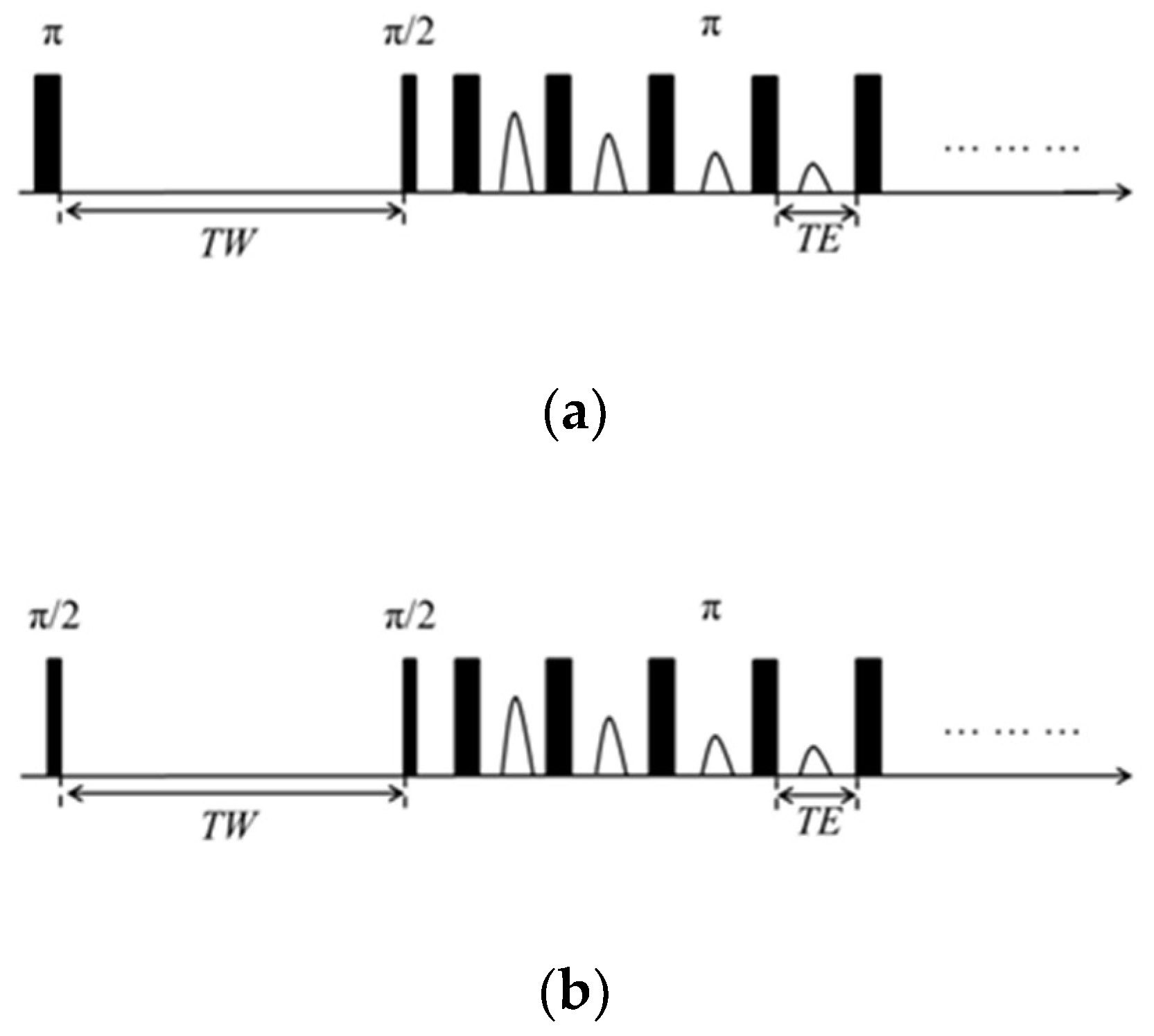
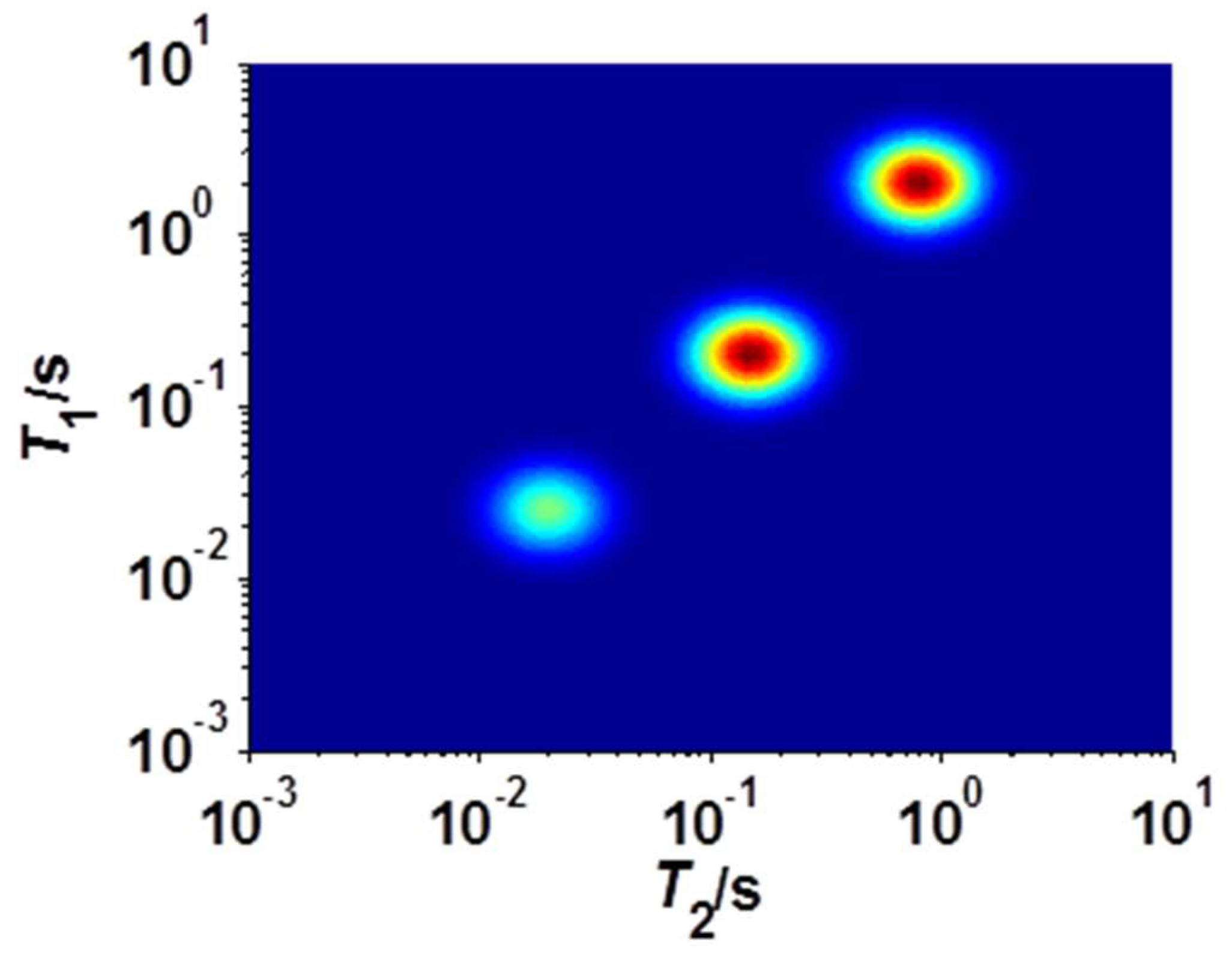
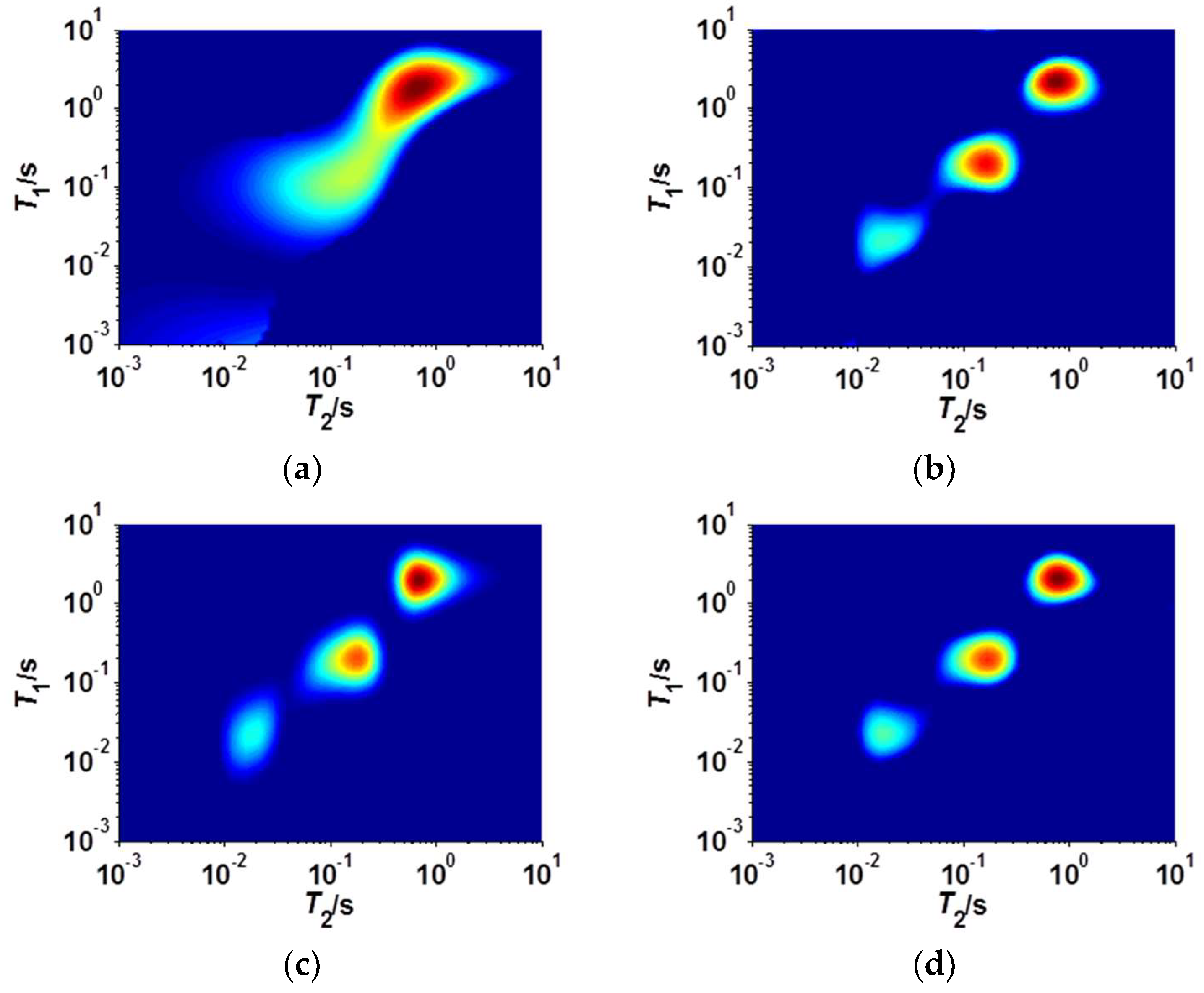
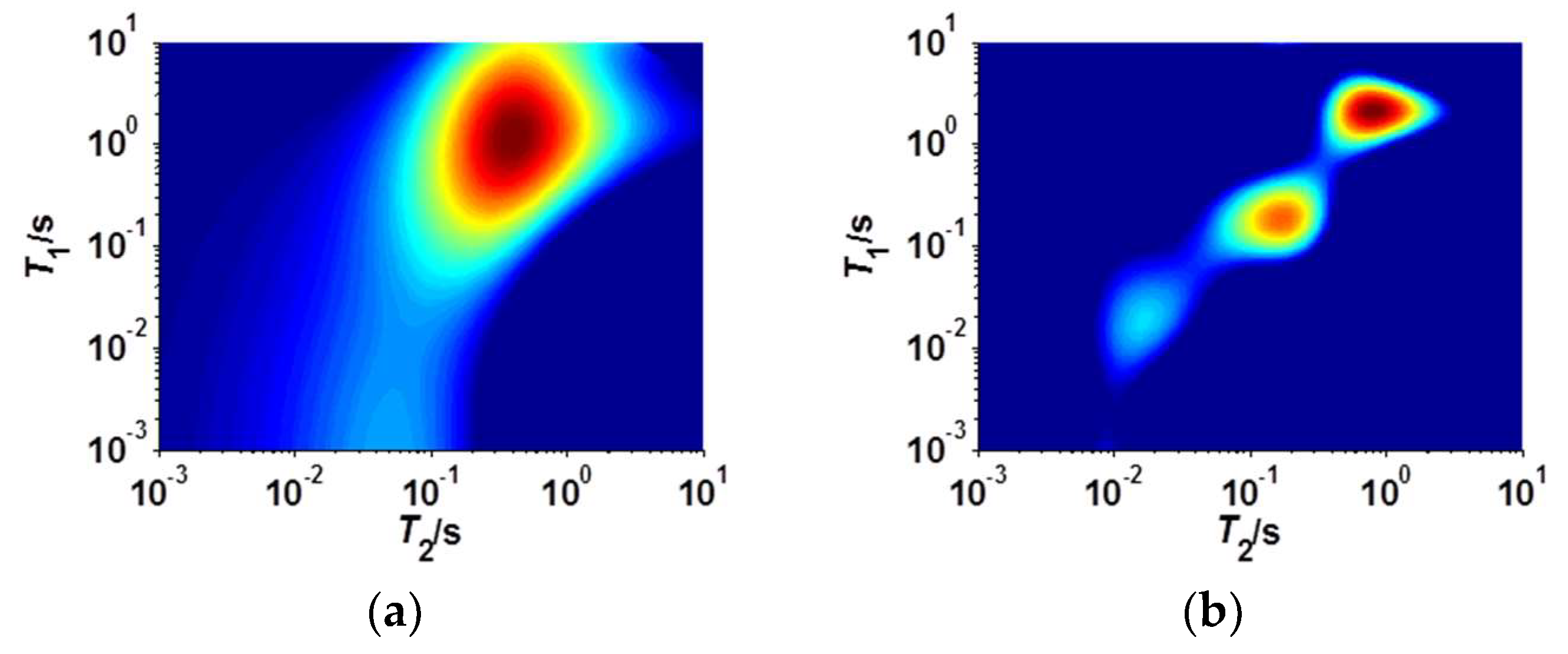
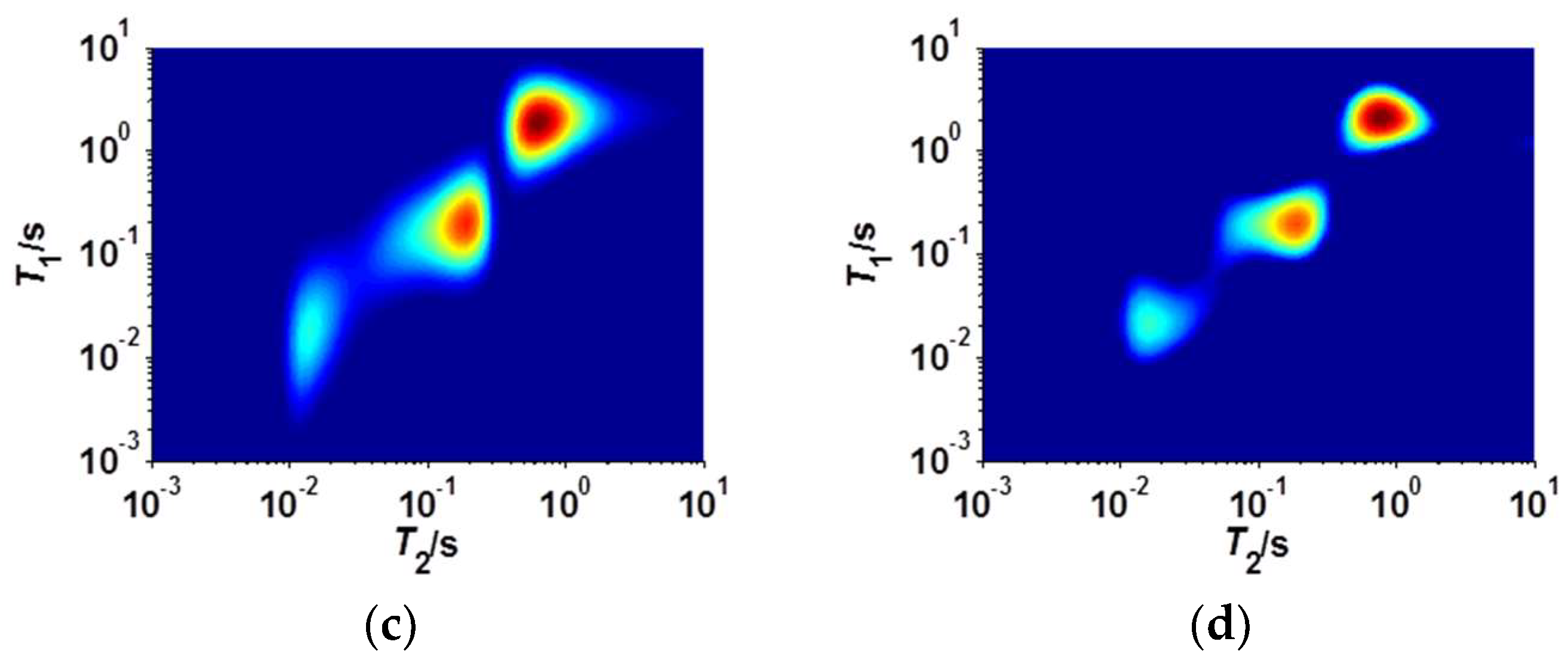
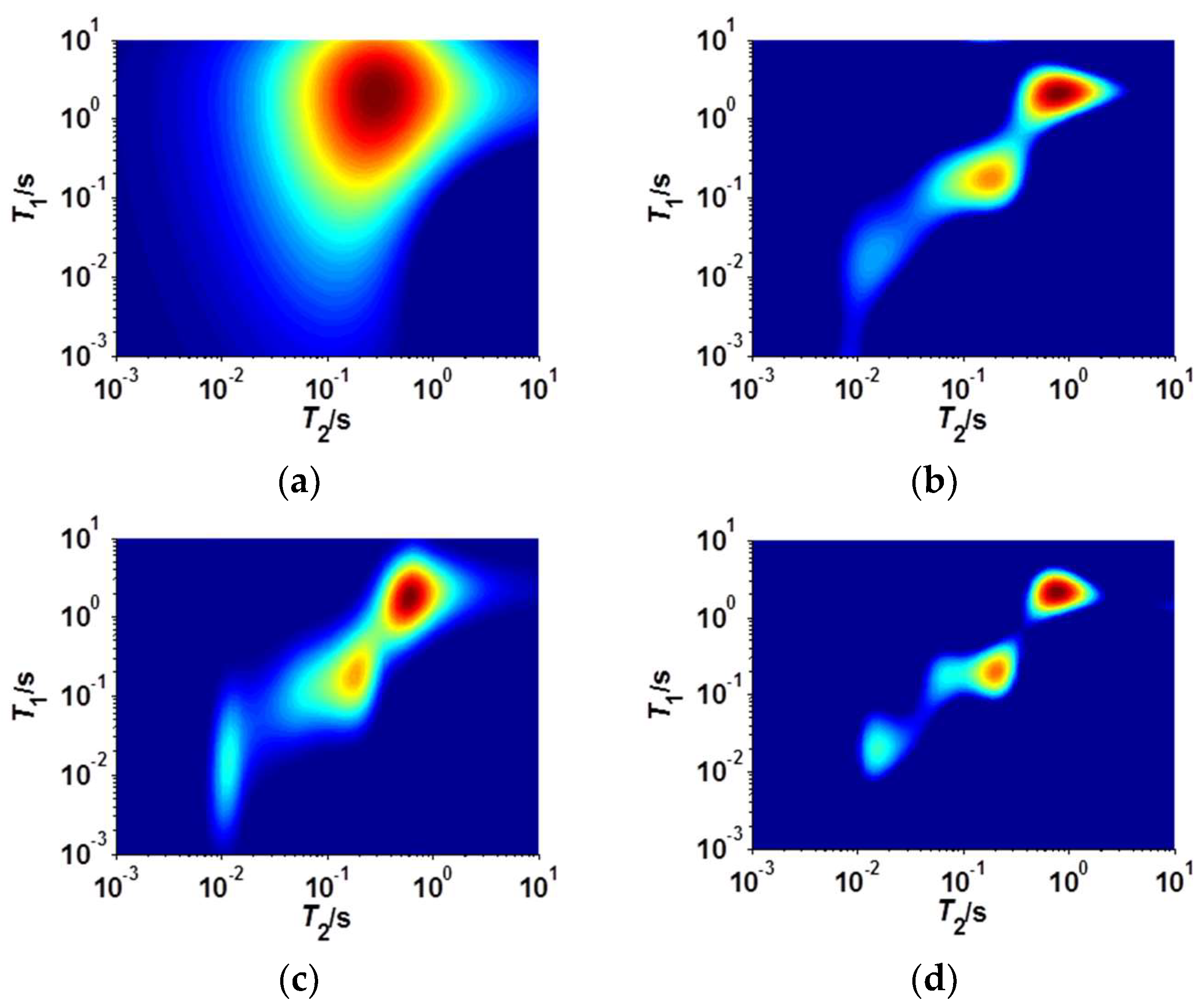
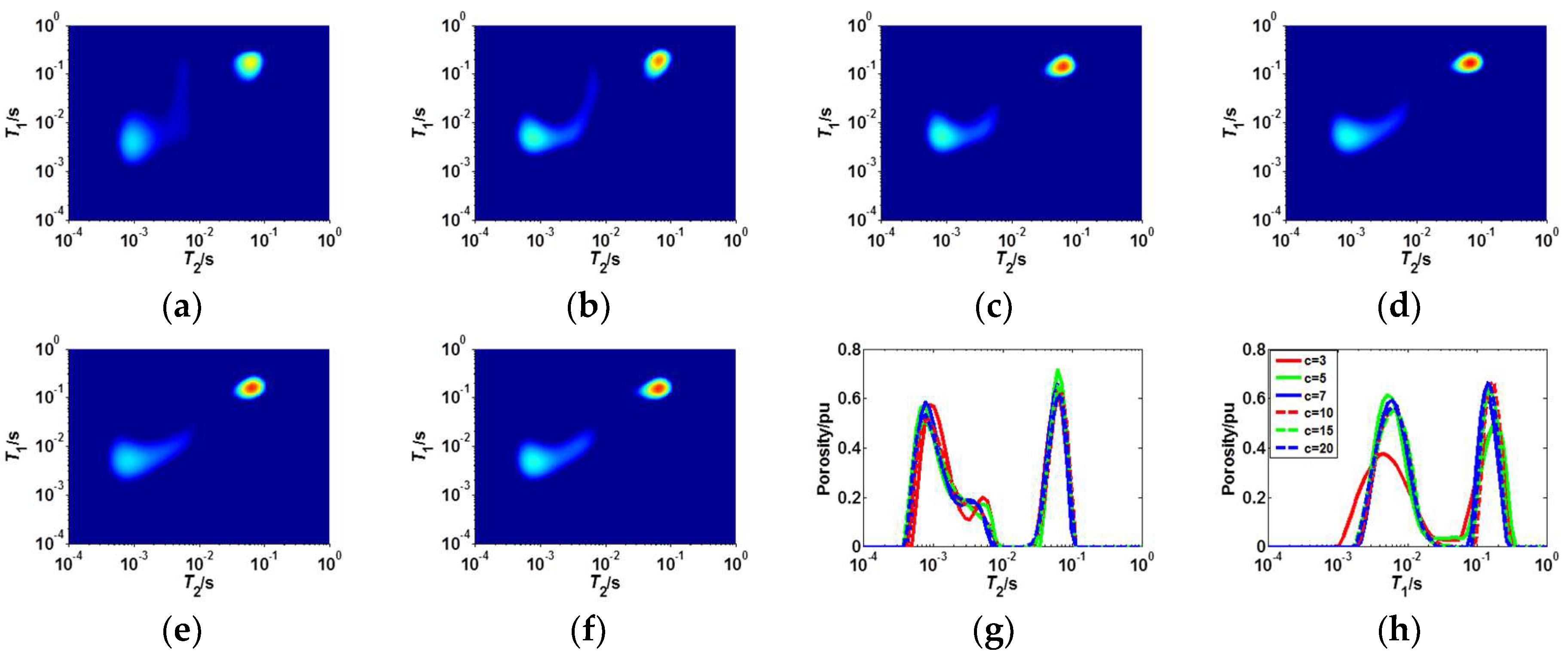
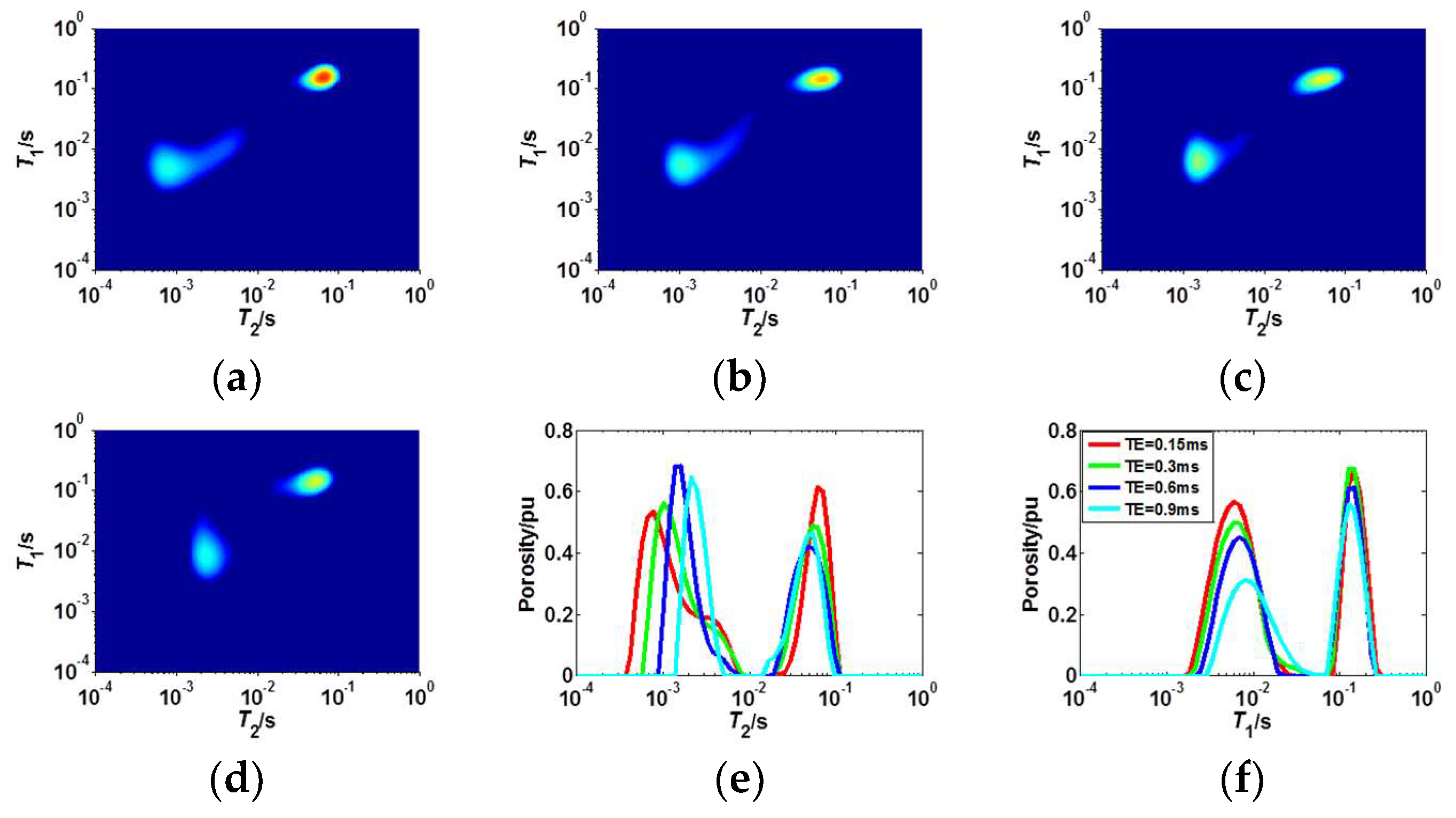
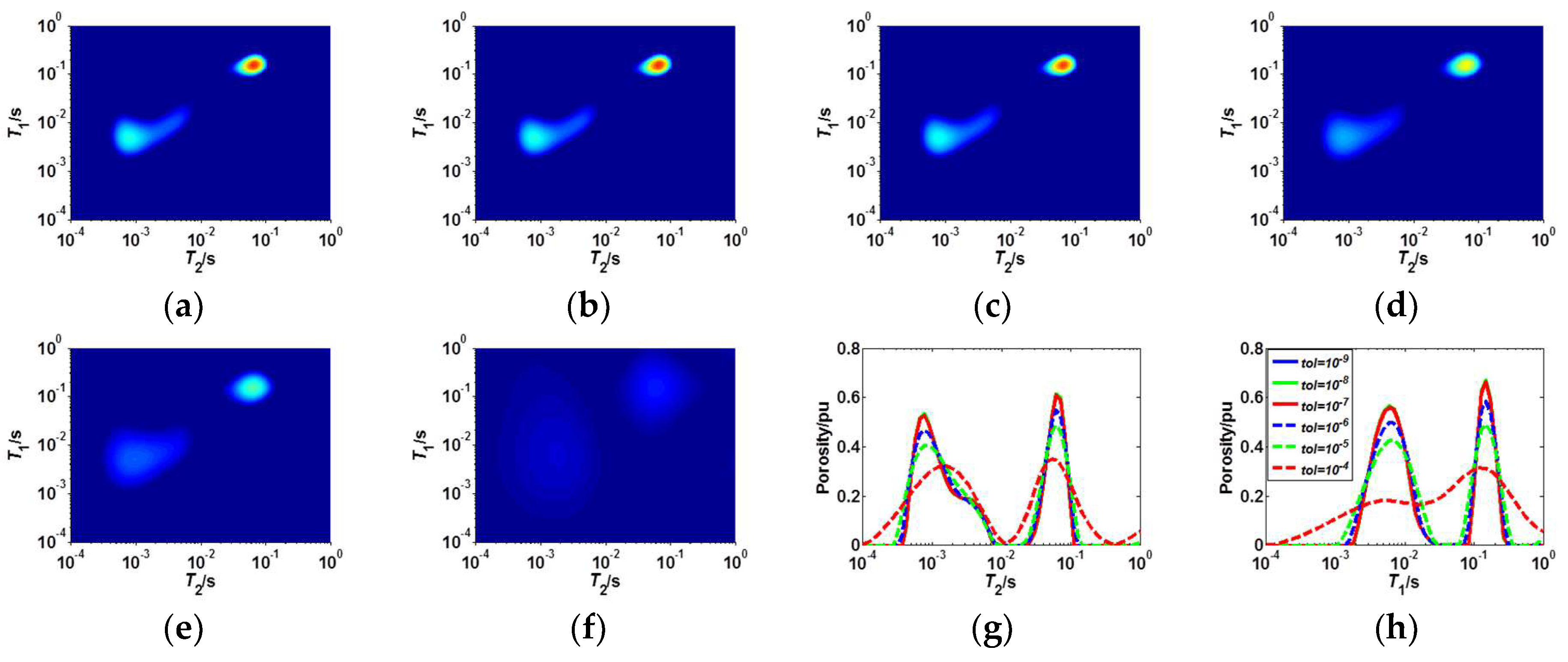
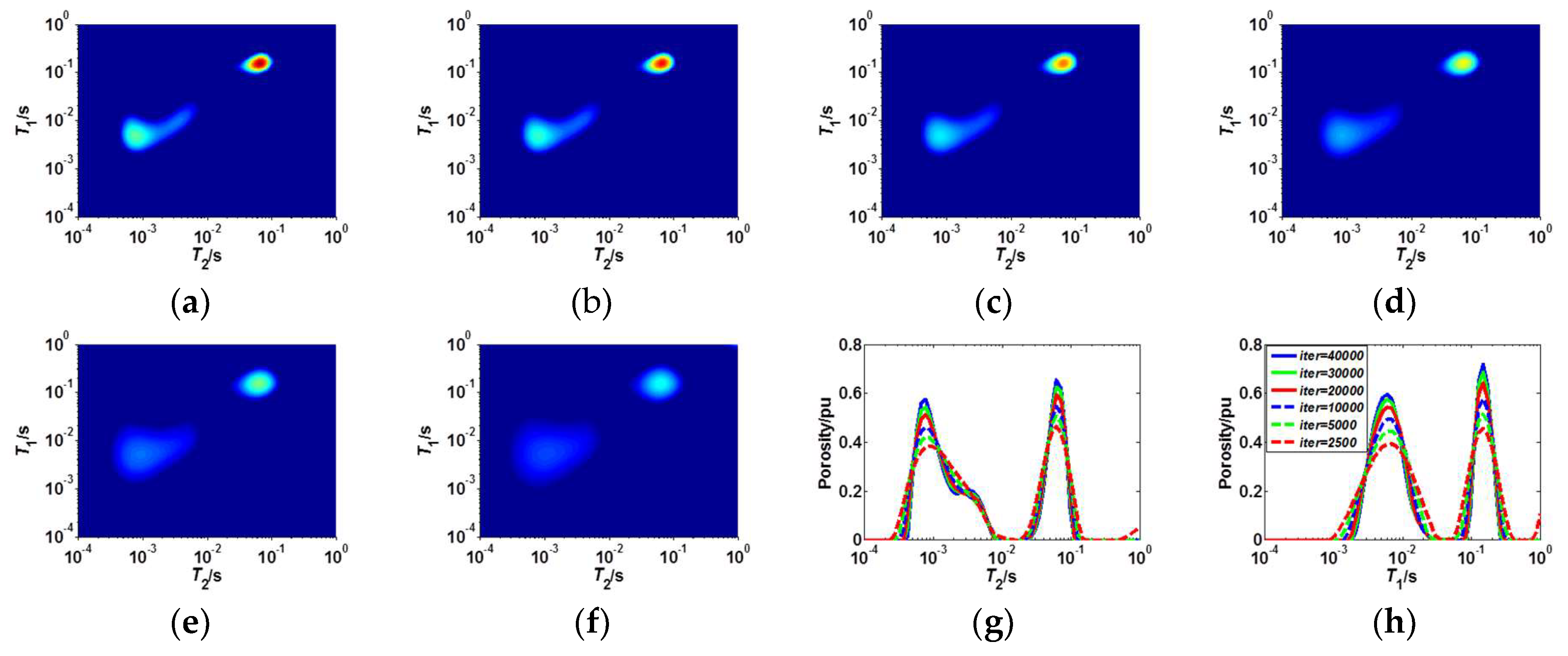


| Algorithm | TSVD | BRD | LM | TIST | ||||||||
|---|---|---|---|---|---|---|---|---|---|---|---|---|
| SNR | 50 | 20 | 10 | 50 | 20 | 10 | 50 | 20 | 10 | 50 | 20 | 10 |
| Porosity (pu) | 15.49 | 16.21 | 16.93 | 15.10 | 15.18 | 15.34 | 15.06 | 15.19 | 15.44 | 15.00 | 15.04 | 15.04 |
| Relative error | 0.74 | 0.87 | 0.90 | 0.27 | 0.43 | 0.54 | 0.34 | 0.52 | 0.69 | 0.27 | 0.34 | 0.44 |
| Residual | 2.01 | 4.00 | 4.97 | 1.10 | 1.75 | 2.50 | 1.16 | 1.88 | 2.73 | 0.86 | 1.36 | 1.93 |
| No | Wait Time Group (ms) |
|---|---|
| 1 | log_stationing (0.0001, 1, 3) |
| 2 | log_stationing (0.0001, 1, 5) |
| 3 | log_stationing (0.0001, 1, 7) |
| 4 | log_stationing (0.0001, 1, 10) |
| 5 | log_stationing (0.0001, 1, 15) |
| 6 | log_stationing (0.0001, 1, 20) |
© 2019 by the authors. Licensee MDPI, Basel, Switzerland. This article is an open access article distributed under the terms and conditions of the Creative Commons Attribution (CC BY) license (http://creativecommons.org/licenses/by/4.0/).
Share and Cite
Guo, J.; Xie, R.; Xiao, L.; Liu, M.; Gao, L. Nuclear Magnetic Resonance T1–T2 Spectra in Heavy Oil Reservoirs. Energies 2019, 12, 2415. https://doi.org/10.3390/en12122415
Guo J, Xie R, Xiao L, Liu M, Gao L. Nuclear Magnetic Resonance T1–T2 Spectra in Heavy Oil Reservoirs. Energies. 2019; 12(12):2415. https://doi.org/10.3390/en12122415
Chicago/Turabian StyleGuo, Jiangfeng, Ranhong Xie, Lizhi Xiao, Mi Liu, and Lun Gao. 2019. "Nuclear Magnetic Resonance T1–T2 Spectra in Heavy Oil Reservoirs" Energies 12, no. 12: 2415. https://doi.org/10.3390/en12122415
APA StyleGuo, J., Xie, R., Xiao, L., Liu, M., & Gao, L. (2019). Nuclear Magnetic Resonance T1–T2 Spectra in Heavy Oil Reservoirs. Energies, 12(12), 2415. https://doi.org/10.3390/en12122415




